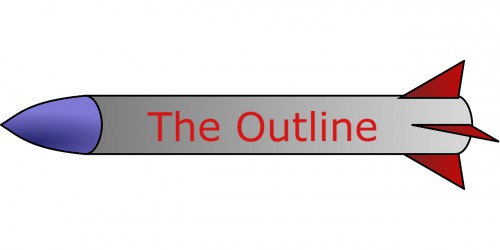It’s the first day of class, and your instructor hands you the syllabus. As you browse through, you get to the list of assignments and your eyes widen–a 15-page research paper is due at the end of the semester.
You’ve never written 15 pages of anything in your whole life. Sure, you have all semester to do it, but some of that time is going to be spent trying to figure out how to write that large of a paper.
Research papers can be pretty scary at first, but there is a secret weapon that can help you overcome some of that fear–The Outline.

A research paper outline will keep your thoughts on track, enabling you to write that mammoth paper with relative ease. It still won’t be the easiest thing you’ve ever done, but imagine the sense of accomplishment you’ll have when you hand in that 15-pager (that’s about 3650 words)!
Research Paper vs. Essay: How Are They Different?
Length: A research paper is considerably longer than an essay. Some are a bit shorter, around 8-10 pages, but they can sometimes be up to 30 pages or more. While many essays can be given as in-class assignments or homework for the week, the length of a research paper requires more time to write it.
Effort: By the same token, research papers also require more effort. The name says it all–research paper. You’ll have to do much more research on a topic than you would for a standard essay assignment in order to do well.
Point of View: While essays are typically about expressing your point of view on a topic, research papers take other scholars’ viewpoints into consideration. From your research, you’ll see what other (credible) sources have to say about your topic and use your own thoughts to either expand or refute those claims.
The Point of It All: A lot of students probably want to know what the point of any writing assignment is. Essays are about improving your skills as a writer and communicator in general. Research papers, on the other hand, are assigned both to improve your writing skills and to improve your knowledge about a subject. With all that research, you’re bound to come out of it with a lot more information about your topic than when you started.
Why You Need a Research Paper Outline
It may be tempting to think that, for the sake of time, you should just jump right into your research paper, skipping the outline completely. But an outline, especially for lengthier papers, will end up saving you some time in the end.
It all boils down to organization. Sure, you could just start writing, but even if you reach the word or page requirement, your paper would probably lack any sort of logical flow. A research paper outline allows you to get your main ideas down and organize them before you get too deep into the actual writing.
Having a good research paper outline also ensures that you don’t leave anything out. While you’re writing, you can just look at the outline and know which section comes next, as well as what to include in that section.
To make this a little easier, I’m going to give you an example of how to put together a sweet research paper outline on the topic of ice cream.

How to Put Your Research Paper Outline Together
Like most essays, your research paper is going to have three main parts: an introduction, a body, and a conclusion. However, what goes into each of these sections–especially the body–is going to be a little different and a lot more in depth.
The sections below give an example of each section of a research paper outline, followed by an explanation of each section.
- Hook
- In 1920, the United States passed Prohibition, nearly crushing the business of breweries like Anheuser-Busch. To stay in business, the breweries turned bars into soda fountains and went into the business of ice cream.
- Research Question
- What effect did Prohibition have on the popularity of ice cream?
- Thesis Statement
- Because of Prohibition, ice cream became nearly as popular as alcohol itself.
Hook: First impressions are everything. Just like an essay, your research paper needs a hook. The hook for a research paper is typically a bit longer, and may consist of an anecdote to create some sort of tension. You don’t need to write the whole anecdote in your outline, but you should write down an idea of how you want to start out.
Research Question: By now, you should have a pretty clear idea of your research question. State it concisely in your outline.
Thesis Statement: Every great research paper has a great thesis statement. This is going be the answer to your research question and the basis for your argument.
- Context
- Brief history of ice cream
- How breweries became soda shops
- Existing Arguments
- Why the consumption of ice cream was on the rise
- How the ice cream trade served as cover-up for alcohol runners
- Why the consumption of ice cream was on the rise
- Your Argument
- More than just a cover-up
- Former bars could be easily converted to soda fountains and ice cream parlors
- Ice cream parlors provided the same sort of social setting as going out to a bar
- More than just a cover-up
Context: You have to assume that your reader doesn’t know the history behind your topic. Giving background, or context, is critical. Again, this doesn’t have to be fully fleshed out in your research paper outline, but you should include your main points.
Existing Arguments: What do other people have to say about your topic? How do they prove their arguments? How convincing are the arguments they are making?
These are some questions you should think about while you’re researching. Include the answers in your outline.
Your Argument: This is the big one. Your argument should be in relation to the existing arguments. You will either agree or expand on what other scholars have to say.
To do this, you need to look at primary sources–sources such as photographs, charts, statistics, music lyrics, letters, newspaper articles, and other documents produced about your topic at the time it took place. You can also use other secondary literature to supplement this material.
For your research paper outline, include the main points of your argument and how you are going to support these points.
- Summary of Main Points
- Prohibition increased sales of ice cream
- Many scholars point to the need to cover up illegal alcohol smuggling
- Ice cream parlors were also easy to build and provided a good social scene for people who were used to bars.
- Why It Matters
- Dramatic changes in laws can have unforeseen consequences. In this case, it was an increase in ice cream consumption, but it may not always be something so sweet.
Summary of Main Points: Briefly go over existing arguments and the main points of your argument. In the research paper outline, these can be short bullet points.
Why It Matters: You did a lot of research, and this topic has become very important to you. Now explain why it should matter to anyone else.
Download the research paper outline template.
Best Practices for Your Research Paper Outline
Include bibliographic information in your outline. When you use specific information or quotes in your outline, be sure to mark exactly where it came from. This will help with your citations later.
Make sure you have enough detail. Research papers are not like essays. Their higher word count requires a lengthier outline. If you only put general information under the introduction, body, and conclusion sections, when it comes time to write the paper, you won’t have enough information to turn to.
Not including enough detail in your outline is almost as bad as not having a research paper outline at all.
After your research paper outline is done, it’s time to start writing. But that blank screen will be easier to tackle if you keep referencing your outline.
If you’re still having some trouble after you’re finished with your paper, let the Kibin editors help straighten out any kinks.
Now… time to start tackling those 15 pages!


